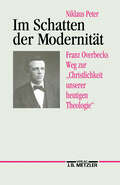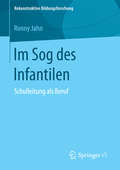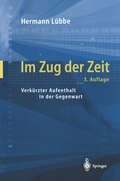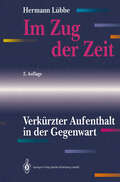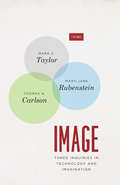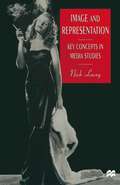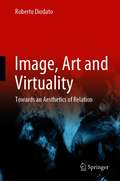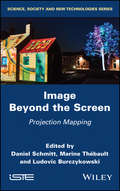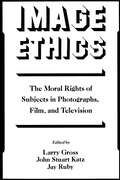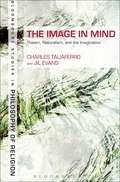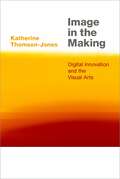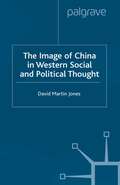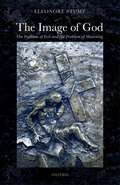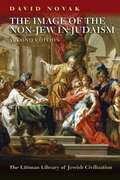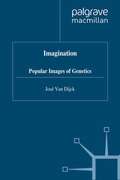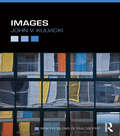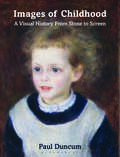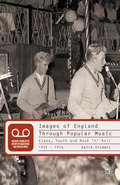- Table View
- List View
Im Schatten der Modernität: Franz Overbecks Weg zur "Christlichkeit unserer heutigen Theologie"
by Niklaus PeterAls "Zwillingspaar aus einem Haus" hat Nietzsche die 1873 fast gleichzeitig erschienen Schriften, seine Erste unzeitgemässe Betrachtung und die seines Freundes Franz Overbeck, "Über die Christlichkeit unserer heutigen Theologie", bezeichnet.
Im Sog des Infantilen: Schulleitung als Beruf (Rekonstruktive Bildungsforschung #9)
by Ronny JahnRonny Jahn geht der Frage nach, was einen Manager im Finanzwesen von einem Schulleiter unterscheidet. Der Autor bietet ungewohnte Einblicke in die tägliche Arbeit von Schulleitern, zeigt, worin sie und Führungskräfte anderer Berufsfelder sich gleichen und unterscheiden und arbeitet dabei die Besonderheit der Schule als Organisation und Institution heraus. Es ist nicht das Managen, das die Arbeit eines Schulleiters prägt. Die besondere Herausforderung in der Leitung einer Schule liegt in der stetigen Auseinandersetzung mit dem Sog des Infantilen in einer Kultur des Machtverdikts.
Im Zug der Zeit: Verkürzter Aufenthalt in der Gegenwart
by Hermann LübbeIn einer dynamischen Zivilisation erhöht sich in Wissenschaft und Technik, in Wirtschaft und Kunst die Neuerungsrate. Die Zeitdauer konstanter Arbeits- und Lebensverhältnisse nimmt ab, der Aufenthalt in der Gegenwart verkürzt sich. Zeit wird knapp und organisationsbedürftig. Hermann Lübbe beschreibt und analysiert die kulturellen, wirtschaftlichen und zeitumgangstechnischen Folgen dieser "Gegenwartsschrumpfung" und zeichnet ein umfassendes Panorama der Zeit-Verfassung unserer modernen Kultur."Der Autor stellt dem Leser den mehr als fraglichen Beschleunigungscharakter unserer modernen Kultur facettenreich und anschaulich vor. Spricht aus, was wir in unserer Angst, uns auf der schnellen Reise selbst zu verlieren, schon fast gar nicht mehr wahrnehmen wollen..." "Das Buch versucht eine Phänomenologie unserer Kultur, deren Äußerungen sich ständig und mit wachsender Geschwindigkeit verändern. Seine Belege sind uns in ihrer Alltäglichkeit überraschend, aber in ihren Einzelheiten plausibel..." (VDI nachrichten magazin bzw. Physikalische Blätter)
Im Zug der Zeit: Verkürzter Aufenthalt in der Gegenwart
by Hermann LübbeZeit wird knapp und organisationsbedürftig. Die Folgen beschreibt der Autor in diesem einzigartigen Panorama der Zeit-Verfassung unserer modernen Kultur.
Image: Three Inquiries in Technology and Imagination (TRIOS)
by Mark C. Taylor Mary-Jane Rubenstein Thomas A. CarlsonThe three essays in Image, written by leading philosophers of religion, explore the modern power of the visual at the intersection of the human and the technological. Modern life is steeped in images, image-making, and attempts to control the world through vision. Mastery of images has been advanced by technologies that expand and reshape vision and enable us to create, store, transmit, and display images. The three essays in Image, written by leading philosophers of religion Mark C. Taylor, Mary-Jane Rubenstein, and Thomas A. Carlson, explore the power of the visual at the intersection of the human and the technological. Building on Heidegger’s notion that modern humanity aims to master the world by picturing or representing the real, they investigate the contemporary culture of the image in its philosophical, religious, economic, political, imperial, and military dimensions, challenging the abstraction, anonymity, and dangerous disconnection of contemporary images. Taylor traces a history of capitalism, focusing on its lack of humility, particularly in the face of mortality, and he considers art as a possible way to reconnect us to the earth. Through a genealogy of iconic views from space, Rubenstein exposes the delusions of conquest associated with extraterrestrial travel. Starting with the pressing issues of surveillance capitalism and facial recognition technology, Carlson extends Heidegger’s analysis through a meditation on the telematic elimination of the individual brought about by totalizing technologies. Together, these essays call for a consideration of how we can act responsibly toward the past in a way that preserves the earth for future generations. Attending to the fragility of material things and to our own mortality, they propose new practices of imagination grounded in love and humility.
Image: Three Inquiries in Technology and Imagination (TRIOS)
by Mark C. Taylor Mary-Jane Rubenstein Thomas A. CarlsonThe three essays in Image, written by leading philosophers of religion, explore the modern power of the visual at the intersection of the human and the technological. Modern life is steeped in images, image-making, and attempts to control the world through vision. Mastery of images has been advanced by technologies that expand and reshape vision and enable us to create, store, transmit, and display images. The three essays in Image, written by leading philosophers of religion Mark C. Taylor, Mary-Jane Rubenstein, and Thomas A. Carlson, explore the power of the visual at the intersection of the human and the technological. Building on Heidegger’s notion that modern humanity aims to master the world by picturing or representing the real, they investigate the contemporary culture of the image in its philosophical, religious, economic, political, imperial, and military dimensions, challenging the abstraction, anonymity, and dangerous disconnection of contemporary images. Taylor traces a history of capitalism, focusing on its lack of humility, particularly in the face of mortality, and he considers art as a possible way to reconnect us to the earth. Through a genealogy of iconic views from space, Rubenstein exposes the delusions of conquest associated with extraterrestrial travel. Starting with the pressing issues of surveillance capitalism and facial recognition technology, Carlson extends Heidegger’s analysis through a meditation on the telematic elimination of the individual brought about by totalizing technologies. Together, these essays call for a consideration of how we can act responsibly toward the past in a way that preserves the earth for future generations. Attending to the fragility of material things and to our own mortality, they propose new practices of imagination grounded in love and humility.
Image and Representation: Key Concepts in Media Studies
by Nick LaceyImage and Representation offers students a lively, clear and practical introduction to two of the most central concepts in the study of media, culture and communication: media language and representation. Aimed at students taking advanced level courses in media or communication studies at school, college or university, possibly being confronted with theories of the media for the first time, this book provides a carefully gradated overview of two essential topics for study.Beginning with the basic components of image analysis, from lighting and viewpoint, it goes on to examine the contribution of semiotics to our understanding of the messages images convey. It then considers theoretical debates around authorial intent, `preferred' readings, ideology and discourse. In its second part, the book explores the web of construction and interpretation involved in representation and looks at important issues to do with stereotyping, propaganda, realism and the documentary.Laced with graphic and memorable examples and case studies taken from a range of contemporary and class media texts, and interspersed with brief suggestions for further activity or study, the book offers a lucid review of key theories that pays due attention to their practical application. As such, it will be of value and relevance to students on a range of different courses, who are in need of a balanced and in-depth guide.
Image, Art and Virtuality: Towards an Aesthetics of Relation
by Roberto DiodatoThis book investigates the ontological state of relations in a unique way. Starting with the notion of system, it shows that the system can be understood as a relational structure, and that relations can be assessed within themselves, with no need to transform relations in elements. “Relations” are understood in contrast to “relational property”: without a relation there is no identity, therefore no existence. What allows us to do that without hypostatizing the relation, and without immediately taking it simply as a causal relation, can be better grasped, possibly, in reference to a few entities that make best display of their systemic nature, for example images, works of art, and virtual bodies.This book shows how virtual bodies are ontological hybrids representing a type of entity that has never appeared in the world before. This entity becomes a phenomenon in interactivity and evades the dichotomy between “external” and “internal”; it is neither a cognitive product of the consciousness, nor an image of the mind. The user is well aware of experiencing anotherreality, also in the sense of a paradoxical reduplication of perceptual synthesis. The virtual body-environment is therefore simultaneously external and internal, with virtual bodies-environments to be seen as artificial windows to an intermediary world. In this intermediary world, the space itself is the result of interactivity; the world takes place in the sense or feeling of immersion experienced by the user; and the body, perceived as “other”, takes upon itself the sense of its reality, of its effectiveness, as an imaginary and pathic incision, as a production of desire and emotion, to the point that the feeling of reality conveyed by a virtual environment will rely significantly on how this environment produces emotions in the users.
Image Beyond the Screen: Projection Mapping
by Daniel Schmitt Marine Thébault Ludovic BurczykowskiVideomapping with its use of digital images is an audiovisual format that has gained traction with the creative industries. It consists of projecting images onto diverse surfaces, according to their geometric characteristics. It is also synonymous with spatial augmented reality, projection mapping and spatial correspondence. Image Beyond the Screen lays the foundations for a field of interdisciplinary study, encompassing the audiovisual, humanities, and digital creation and technologies. It brings together contributions from researchers, and testimonials from some of the creators, technicians and organizers who now make up the many-faceted community of videomapping. Live entertainment, museum, urban or event planning, cultural heritage, marketing, industry and the medical field are just a few examples of the applications of this media.
Image Beyond the Screen: Projection Mapping
by Daniel Schmitt Marine Thébault Ludovic BurczykowskiVideomapping with its use of digital images is an audiovisual format that has gained traction with the creative industries. It consists of projecting images onto diverse surfaces, according to their geometric characteristics. It is also synonymous with spatial augmented reality, projection mapping and spatial correspondence. Image Beyond the Screen lays the foundations for a field of interdisciplinary study, encompassing the audiovisual, humanities, and digital creation and technologies. It brings together contributions from researchers, and testimonials from some of the creators, technicians and organizers who now make up the many-faceted community of videomapping. Live entertainment, museum, urban or event planning, cultural heritage, marketing, industry and the medical field are just a few examples of the applications of this media.
Image Ethics: The Moral Rights of Subjects in Photographs, Film, and Television (Communication and Society)
by Larry Gross John Stuart Katz Jay RubyThis pathbreaking collection of thirteen original essays examines the moral rights of the subjects of documentary film, photography, and television. Image makers--photographers and filmmakers--are coming under increasing criticism for presenting images of people that are considered intrusive and embarrassing to the subject. Portraying subjects in a "false light," appropriating their images, and failing to secure "informed consent" are all practices that intensify the debate between advocates of the right to privacy and the public's right to know. Discussing these questions from a variety of perspectives, the authors here explore such issues as informed consent, the "right" of individuals and minority groups to be represented fairly and accurately, the right of individuals to profit from their own image, and the peculiar moral obligations of minorities who image themselves and the producers of autobiographical documentaries. The book includes a series of provocative case studies on: the documentaries of Frederick Wiseman, particularly Titicut Follies; British documentaries of the 1930s; the libel suit of General Westmoreland against CBS News; the film Witness and its portrayal of the Amish; the film The Gods Must be Crazy and its portrayal of the San people of southern Africa; and the treatment of Arabs and gays on television. The first book to explore the moral issues peculiar to the production of visual images, Image Ethics will interest a wide range of general readers and students and specialists in film and television production, photography, communications, media, and the social sciences.
The Image in Mind: Theism, Naturalism, and the Imagination (Continuum Studies in Philosophy of Religion)
by Charles Taliaferro Jil EvansA philosophical inquiry into the strengths and weaknesses of theism and naturalism in accounting for the emergence of consciousness, the visual imagination and aesthetic values. The authors begin by offering an account of modern scientific practice which gives a central place to the visual imagination and aesthetic values. They then move to test the explanatory power of naturalism and theism in accounting for consciousness and the very visual imagination and aesthetic values that lie behind and define modern science. Taliaferro and Evans argue that evolutionary biology alone is insufficient to account for consciousness, the visual imagination and aesthetic values. Insofar as naturalism is compelled to go beyond evolutionary biology, it does not fare as well as theism in terms of explanatory power.
The Image in Mind: Theism, Naturalism, and the Imagination (Bloomsbury Studies in Philosophy of Religion)
by Charles Taliaferro Jil EvansA philosophical inquiry into the strengths and weaknesses of theism and naturalism in accounting for the emergence of consciousness, the visual imagination and aesthetic values. The authors begin by offering an account of modern scientific practice which gives a central place to the visual imagination and aesthetic values. They then move to test the explanatory power of naturalism and theism in accounting for consciousness and the very visual imagination and aesthetic values that lie behind and define modern science. Taliaferro and Evans argue that evolutionary biology alone is insufficient to account for consciousness, the visual imagination and aesthetic values. Insofar as naturalism is compelled to go beyond evolutionary biology, it does not fare as well as theism in terms of explanatory power.
Image in the Making: Digital Innovation and the Visual Arts (Thinking Art)
by Katherine Thomson-JonesHuman beings have always made images, and to do so they have developed and refined an enormous range of artistic tools and materials. With the development of digital technology, the ways of making images - whether they are still or moving, 2D or 3D - have evolved at an unprecedented rate. At every stage of image making, artists now face a choice between using analog and using digital tools. Yet a digital image need not look digital; and likewise, a hand-made image or traditional photograph need not look analog. If we do not see the artist's choice between the analog and the digital, what difference can this choice make for our appreciation of images in the digital age? Image in the Making answers this question by accounting for the fundamental distinction between the analog and the digital; by explicating the technological realization of this distinction in image-making practice; and by exploring the creative possibilities that are distinctive of the digital. Katherine Thomson-Jones makes the case for a new kind of appreciation in the digital age. In appreciating the images involved in every digital art form - from digital video installation to net art to digital cinema - there is a basic truth that we cannot ignore: The nature and technology of the digital expands both what an image can be as an image and what an image can be for us as human beings.
Image in the Making: Digital Innovation and the Visual Arts (Thinking Art)
by Katherine Thomson-JonesHuman beings have always made images, and to do so they have developed and refined an enormous range of artistic tools and materials. With the development of digital technology, the ways of making images - whether they are still or moving, 2D or 3D - have evolved at an unprecedented rate. At every stage of image making, artists now face a choice between using analog and using digital tools. Yet a digital image need not look digital; and likewise, a hand-made image or traditional photograph need not look analog. If we do not see the artist's choice between the analog and the digital, what difference can this choice make for our appreciation of images in the digital age? Image in the Making answers this question by accounting for the fundamental distinction between the analog and the digital; by explicating the technological realization of this distinction in image-making practice; and by exploring the creative possibilities that are distinctive of the digital. Katherine Thomson-Jones makes the case for a new kind of appreciation in the digital age. In appreciating the images involved in every digital art form - from digital video installation to net art to digital cinema - there is a basic truth that we cannot ignore: The nature and technology of the digital expands both what an image can be as an image and what an image can be for us as human beings.
The Image of China in Western Social and Political Thought
by D. JonesDavid Martin Jones examines how China has been portrayed in European and subsequently North American social and political thought and what, if anything, this depiction tells us about the character of this thought. Such a question immediately evokes the spectre of orientalism and subsequent chapters explore whether the identification of an orientalist project invalidates the knowledge claims of European and North American social and political thought as it evolved from the eighteenth to the twentieth century.
The Image of God: The Problem of Evil and the Problem of Mourning
by Eleonore StumpThe problem of evil has generated varying attempts at theodicy. To show that suffering is defeated for a sufferer, a theodicy argues that there is an outweighing benefit which could not have been gotten without the suffering. Typically, this condition has the tacit presupposition given that this is a post-Fall world. Consequently, there is a sense in which human suffering would not be shown to be defeated even if there were a successful theodicy because a theodicy typically implies that the benefit in question could have been gotten without the suffering if there had not been a Fall. There is a part of the problem of evil that would remain, then, even if there were a successful theodicy. This is the problem of mourning: even defeated suffering in the post-Fall world merits mourning. How is this warranted mourning compatible with the existence of an omniscient, omnipotent, perfectly good God? The traditional response to this problem is the felix culpa view, which maintains that the original sin was fortunate because there is an outweighing benefit to sufferers that could not be gotten in a world without suffering. The felix culpa view presupposes an object of evaluation, namely, the true self of a human being, and a standard of evaluation for human lives. This book explores these and a variety of other topics in philosophical theology in order to explain and evaluate the role of suffering in human lives.
The Image of God: The Problem of Evil and the Problem of Mourning
by Eleonore StumpThe problem of evil has generated varying attempts at theodicy. To show that suffering is defeated for a sufferer, a theodicy argues that there is an outweighing benefit which could not have been gotten without the suffering. Typically, this condition has the tacit presupposition given that this is a post-Fall world. Consequently, there is a sense in which human suffering would not be shown to be defeated even if there were a successful theodicy because a theodicy typically implies that the benefit in question could have been gotten without the suffering if there had not been a Fall. There is a part of the problem of evil that would remain, then, even if there were a successful theodicy. This is the problem of mourning: even defeated suffering in the post-Fall world merits mourning. How is this warranted mourning compatible with the existence of an omniscient, omnipotent, perfectly good God? The traditional response to this problem is the felix culpa view, which maintains that the original sin was fortunate because there is an outweighing benefit to sufferers that could not be gotten in a world without suffering. The felix culpa view presupposes an object of evaluation, namely, the true self of a human being, and a standard of evaluation for human lives. This book explores these and a variety of other topics in philosophical theology in order to explain and evaluate the role of suffering in human lives.
The Image of the Non-Jew in Judaism: The Idea of Noahide Law (The Littman Library of Jewish Civilization)
by David NovakThroughout history the image of the non-Jew in Judaism has profoundly influenced the way in which Jews interact with non-Jews. It has also shaped the understanding that Jews have of their own identity, as it determines just what distinguishes them from the non-Jews around them. A crucial element in this is the concept of Noahide law, understood by the ancient rabbis and subsequent Jewish thinkers as incumbent upon all humankind, unlike the full 613 divine commandments of the Torah, which are incumbent on Jews alone. The approach adopted in this now classic study is to consider the history of the idea of Noahide law, and to show how the concept is relevant to practical discussions of the halakhah pertaining to non-Jews and to relations between Jews and non-Jews. The seven chapters that make up the first part of the study examine each of the Noahide laws in turn, with a view to showing their halakhic development in the rabbinic sources, in the codes, and in the responsa literature. The discussion draws primarily on classical texts by traditional commentators as they attempt to deal with living issues from the rabbinic world as equally vital concerns in their own time. The second part deals with the theory of Noahide law, concluding with a consideration of why it is an appropriate starting point for Jewish philosophy today.
Imagenation: Popular Images of Genetics
by José Van DijckGenetics seems more popular then ever. DNA technology not only sustains large areas of biomedicine and business, but also prevails in social and legal practices and takes root in cultural products. Since the late 1950s, the public image of genetics metamorphosed from a suspect branch of research into a thriving, well-funded field of biomedicine. Images and imaginations have played a crucial role in the popularization of genetic knowledge. The media played up images of engineered bugs, scientists promoted images of selfish genes and science fiction writers infested the imagination with stories of cloned monsters. Imag e nation examines the role of science, journalism and fiction in the popularization of genetics.
Images (New Problems of Philosophy)
by John V. KulvickiThe nature of representation is a central topic in philosophy. This is the first book to connect problems with understanding representational artifacts, like pictures, diagrams, and inscriptions, to the philosophies of science, mind, and art. Can images be a source of knowledge? Are images merely conventional signs, like words? What is the relationship between the observer and the observed? In this clear and stimulating introduction to the problem John V. Kulvicki explores these questions and more. He discusses: the nature of pictorial experience and "seeing in" recognition, resemblance, pretense, and structural theories of depiction images as aids to scientific discovery and understanding mental imagery and the nature of perceptual content photographs as visual prostheses. In so doing he assesses central problems in the philosophy of images, such as how objects we make come to represent other things, and how we distinguish kinds of representation - pictures, diagrams, graphs - from one another. Essential reading for students and professional philosophers alike, the book also contains chapter summaries, annotated further reading, and a glossary.
Images: Their Structure And Content (New Problems of Philosophy)
by John V. KulvickiThe nature of representation is a central topic in philosophy. This is the first book to connect problems with understanding representational artifacts, like pictures, diagrams, and inscriptions, to the philosophies of science, mind, and art. Can images be a source of knowledge? Are images merely conventional signs, like words? What is the relationship between the observer and the observed? In this clear and stimulating introduction to the problem John V. Kulvicki explores these questions and more. He discusses: the nature of pictorial experience and "seeing in" recognition, resemblance, pretense, and structural theories of depiction images as aids to scientific discovery and understanding mental imagery and the nature of perceptual content photographs as visual prostheses. In so doing he assesses central problems in the philosophy of images, such as how objects we make come to represent other things, and how we distinguish kinds of representation - pictures, diagrams, graphs - from one another. Essential reading for students and professional philosophers alike, the book also contains chapter summaries, annotated further reading, and a glossary.
Images of Childhood: A Visual History From Stone to Screen
by Paul DuncumDrawing on a rich legacy of pictorial evidence, Images of Childhood examines historical constructions of childhood and how they reinforce or challenge the prevailing view of childhood as a state of innocence. Each chapter explores how visual elements such as framing, points-of view, and lighting, as well as clothes, accessories, and body language, help to construct our many different conceptions of children: from members of the family unit and assumed gender roles; to schooling and aesthetic objects; through to their economic value and use in political propaganda.Skillfully navigating a multitude of perspectives on this topic, Paul Duncum considers both how our ideas, beliefs and values have changed throughout history and how some have remained unchanged. He also explores the cultural notion of “the child within” and how this has contributed to the way adults perceive children. The result is a text far broader in scope than any other in its field, as art history is interweaved with contemporary popular culture to explore how we visually represent childhood. In doing so, the book highlights the real-life implications that these representations have on children's rights.
Images of Childhood: A Visual History From Stone to Screen
by Paul DuncumDrawing on a rich legacy of pictorial evidence, Images of Childhood examines historical constructions of childhood and how they reinforce or challenge the prevailing view of childhood as a state of innocence. Each chapter explores how visual elements such as framing, points-of view, and lighting, as well as clothes, accessories, and body language, help to construct our many different conceptions of children: from members of the family unit and assumed gender roles; to schooling and aesthetic objects; through to their economic value and use in political propaganda.Skillfully navigating a multitude of perspectives on this topic, Paul Duncum considers both how our ideas, beliefs and values have changed throughout history and how some have remained unchanged. He also explores the cultural notion of “the child within” and how this has contributed to the way adults perceive children. The result is a text far broader in scope than any other in its field, as art history is interweaved with contemporary popular culture to explore how we visually represent childhood. In doing so, the book highlights the real-life implications that these representations have on children's rights.
Images of England Through Popular Music: Class, Youth and Rock 'n' Roll, 1955-1976
by K. GildartDrawing on archival sources and oral testimony, Keith Gildart examines the ways in which popular music played an important role in reflecting and shaping social identities and working-class cultures and - through a focus on rock 'n' roll, rhythm & blues, punk, mod subculture, and glam rock - created a sense of crisis in English society.
